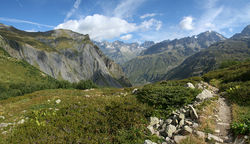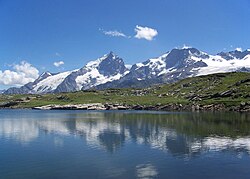Hautes-Alpes
Hautes-Alpes (Occitan: [Auts Aups] Error: {{Lang}}: text has italic markup (help)) is a department in southeastern France, in the Provence-Alpes-Côte d'Azur region. It is named after the Alps mountain range and its prefecture (capital) is Gap.
 | |
 Location of Hautes-Alpes in France | |
| Coordinates: 44°40′N 6°20′E / 44.667°N 6.333°ECoordinates: 44°40′N 6°20′E / 44.667°N 6.333°E | |
| Country | France |
| Region | Provence-Alpes-Côte d'Azur |
| Département | 4 March 1790 |
| Prefecture | Gap |
| Subprefectures | Briançon |
| Government | |
| • President | Jean-Marie Bernard[1] |
| Area | |
| • Total | 5,548.7 km2 (2,142.4 sq mi) |
| Population (2014)[3] | |
| • Total | 139,883 |
| • Density | 25.2100/km2 (65.2937/sq mi) |
| Time zone | UTC+1 (CET) |
| • Summer (DST) | UTC+2 (CEST) |
| ISO 3166 code | FR-05 |
| Arrondissements | 2 |
| Cantons | 15 |
| Communes | 167 |
| Website | www.hautes-alpes.fr |
History
The department of the Hautes-Alpes was one of the 83 original departments created during the French Revolution on 4 March 1790 with the southeastern part of the old province of the Dauphiné.
It was divided in four districts: Briançon, Embrun, Gap and Serres, with Chorges as its capital but during that same year the capital was moved to Gap.[4]
In 1800, with the creation of the arrondissements in France, the four districts were changed into three arrondissements: Gap, Briançon and Embrun.[4]
On 10 September 1926, the arrondissement of Embrun was eliminated.[4]
After the Battle of Waterloo in 1815, the department was occupied by troops from Austria and of the Kingdom of Sardinia.
During World War II, the department was occupied by the fascist Italy.
Geography
Hautes-Alpes is part of the Provence-Alpes-Côte d'Azur region. It has an area of 5,548.7 km2 (2,142 sq mi).[2]
The department is surrounded by the Piedmont region (Italy) and four departments in two regions:
- Provence-Alpes-Côte d'Azur region
- Alpes-de-Haute-Provence (south)
- Auvergne-Rhône-Alpes region
Hautes-Alpes is in the Alps mountain range. The average elevation is over 1,000 m (3,300 ft). The third highest commune in all of Europe is the village of Saint-Véran. Gap and Briançon are the highest prefecture and subprefecture in France.
The highest point is Barre des Écrins (44°55′19″N 06°21′34″E / 44.92194°N 6.35944°E), in the commune of Pelvoux; it is 4,102 m (13,458 ft) high.[5] The lowest point is in the valley of the Buëch river, with an altitude of 470 m (1,542 ft).
The main rivers in Hautes-Alpes are the Durance, a tributary of the Rhône river, Buëch and Drac.
Climate
The Köppen climate classification type for the climate at Embrun is an "Oceanic climate" (also known as Marine West Coast Climate) and of the subtype "Cfc".[6]
The average amount of precipitation for the year in Embrun is 1,173.5 mm (46.2 in). The month with the most precipitation on average is May with 119.4 mm (4.7 in) of precipitation. The month with the least precipitation on average is July with an average of 66 mm (2.6 in).
The average temperature for the year in Embrun is 10.7 °C (51.3 °F). The warmest month, on average, is July with an average temperature of 20.2 °C (68.4 °F). The coolest month on average is January, with an average temperature of 2 °C (36 °F).
| Climate data for Embrun, France | |||||||||||||
|---|---|---|---|---|---|---|---|---|---|---|---|---|---|
| Month | Jan | Feb | Mar | Apr | May | Jun | Jul | Aug | Sep | Oct | Nov | Dec | Year |
| Average high °C (°F) | 6.8 (44.2) |
8.4 (47.1) |
12.4 (54.3) |
15.2 (59.4) |
19.7 (67.5) |
23.8 (74.8) |
27.3 (81.1) |
27.0 (80.6) |
22.3 (72.1) |
17.1 (62.8) |
10.8 (51.4) |
7.1 (44.8) |
16.49 (61.69) |
| Daily mean °C (°F) | 2 (36) |
3 (37) |
6.5 (43.7) |
9.3 (48.7) |
13.6 (56.5) |
17.2 (63) |
20.2 (68.4) |
20 (68) |
16 (61) |
11.7 (53.1) |
6 (43) |
2.7 (36.9) |
10.7 (51.2) |
| Average low °C (°F) | -2.8 (27) |
-2.5 (27.5) |
0.6 (33.1) |
3.4 (38.1) |
7.5 (45.5) |
10.6 (51.1) |
13.1 (55.6) |
12.9 (55.2) |
9.6 (49.3) |
6.2 (43.2) |
1.1 (34) |
-1.7 (28.9) |
4.83 (40.7) |
| Rainfall mm (inches) | 91.7 (3.61) |
83.2 (3.276) |
84.7 (3.335) |
115.5 (4.547) |
118.4 (4.661) |
88.7 (3.492) |
67.1 (2.642) |
84.2 (3.315) |
109.3 (4.303) |
114.3 (4.5) |
108.7 (4.28) |
108.2 (4.26) |
1,174 (46.22) |
| Source: Weatherbase.com [1] | |||||||||||||
Administration
Hautes-Alpes is managed by the Departmental Council of Hautes-Alpes in Gap. The department is part of the Provence-Alpes-Côte d'Azur region.
Administrative divisions
There are 2 arrondissements (districts), 15 cantons and 167 communes (municipalities) in Hautes-Alpes.[7]
| INSEE code |
Arrondissement | Capital | Population[8] (2014) |
Area[9] (km²) |
Density (Inh./km²) |
Communes |
|---|---|---|---|---|---|---|
| 051 | Briançon | Briançon | 35,752 | 2,138.1 | 16.7 | 37 |
| 052 | Gap | Gap | 104,131 | 3,410.5 | 30.5 | 130 |
The following is a list of the 15 cantons of the Hautes-Alpes department (with their INSEE codes), following the French canton reorganisation which came into effect in March 2015:[10]
- L'Argentière-la-Bessée (0501)
- Briançon-1 (0502)
- Briançon-2 (0503)
- Chorges (0504)
- Embrun (0505)
- Gap-1 (0506)
- Gap-2 (0507)
- Gap-3 (0508)
- Gap-4 (0509)
- Guillestre (0510)
- Laragne-Montéglin (0511)
- Saint-Bonnet-en-Champsaur (0512)
- Serres (0513)
- Tallard (0514)
- Veynes (0515)
Demographics
The inhabitants of Hautes-Alpes are known, in French, as Haut-Alpins (women: Haut-Alpines).[11]
Hautes-Alpes had a population, in 2013, of 139,883,[3] for a population density of 25.2 inhabitants/km2. The arrondissement of Gap, with 104,131 inhabitants, is the arrondissement with more inhabitants.[8]
Evolution of the population in Hautes-Alpes

The communes in the department with more inhabitants are:[8]
| City | Population (2014)[8] |
Arrondissement |
|---|---|---|
| Gap | 40,225 | Gap |
| Briançon | 12,392 | Briançon |
| Embrun | 6,150 | Gap |
| Laragne-Montéglin | 3,480 | Gap |
| Veynes | 3,151 | Gap |
| Chorges | 2,791 | Gap |
| La Bâtie-Neuve | 2,468 | Gap |
| Guillestre | 2,323 | Briançon |
| L'Argentière-la-Bessée | 2,317 | Briançon |
| Tallard | 2,061 | Gap |
| Saint-Bonnet-en-Champsaur | 2,034 | Gap |
Gallery
Fort Queyras.
Hautes-Alpes Media
The Alps and the Guil valley seen from Fort Mont-Dauphin
Related pages
References
- ↑ "Jean-Marie BERNARD". Conseil Général des Hautes-Alpes. Archived from the original on 27 June 2017. Retrieved 27 September 2016.
- ↑ 2.0 2.1 "Département des Alpes-de-Hautes-Alpes (05) - Résumé statistique". Publications et statistiques pour la France ou les régions (in French). Institut national de la statistique et des études économiques - INSEE. Retrieved 27 September 2016.
{{cite web}}: CS1 maint: unrecognized language (link) - ↑ 3.0 3.1 "Populations légales 2014 des départements et des collectivités d'outre-mer" (in French). Institut national de la statistique et des études économiques - INSEE. Retrieved 16 July 2017.
{{cite web}}: CS1 maint: unrecognized language (link) - ↑ 4.0 4.1 4.2 "Historique des Hautes-Alpes". Le SPLAF (in French). Retrieved 27 September 2016.
{{cite web}}: CS1 maint: unrecognized language (link) - ↑ "Barre des Écrins, France". Peakbagger.com. Retrieved 27 September 2016.
- ↑ "Embrun, France - Köppen Climate Classification". Weatherbase. Retrieved 27 September 2016.
- ↑ "Département des Hautes-Alpes (05)". Géographie administrative et d'étude (in French). Institut national de la statistique et des études économiques - INSEE. Retrieved 16 July 2017.
{{cite web}}: CS1 maint: unrecognized language (link) - ↑ 8.0 8.1 8.2 8.3 "Régions, départements, arrondissements, cantons et communes" (PDF). Populations légales 2014 (in French). Institut national de la statistique et des études économiques - INSEE. Retrieved 16 July 2017.
{{cite web}}: CS1 maint: unrecognized language (link) - ↑ "Département des Alpes-de-Haute-Provence (04)". Comparateur de territoire (in French). Institut national de la statistique et des études économiques - INSEE. Retrieved 16 July 2017.
{{cite web}}: CS1 maint: unrecognized language (link) - ↑ "Décret n° 2014-193 du 20 février 2014 portant délimitation des cantons dans le département des Hautes-Alpes" (in French). Légifrance.gouv.fr. Retrieved 27 September 2016.
{{cite web}}: CS1 maint: unrecognized language (link) - ↑ "Habitants du départment: Hautes-Alpes (05)" (in French). habitants.fr. Retrieved 27 September 2016.
{{cite web}}: CS1 maint: unrecognized language (link)
Other websites
| Wikimedia Commons has media related to Lua error in Module:Commons_link at line 62: attempt to index field 'wikibase' (a nil value).. |
| Wikivoyage has a travel guide about: Hautes-Alpes |
- Departmental Council website (in French)
- Prefecture website (in French)
- Hautes-Alpes tourism Archived 2016-09-13 at the Wayback Machine













